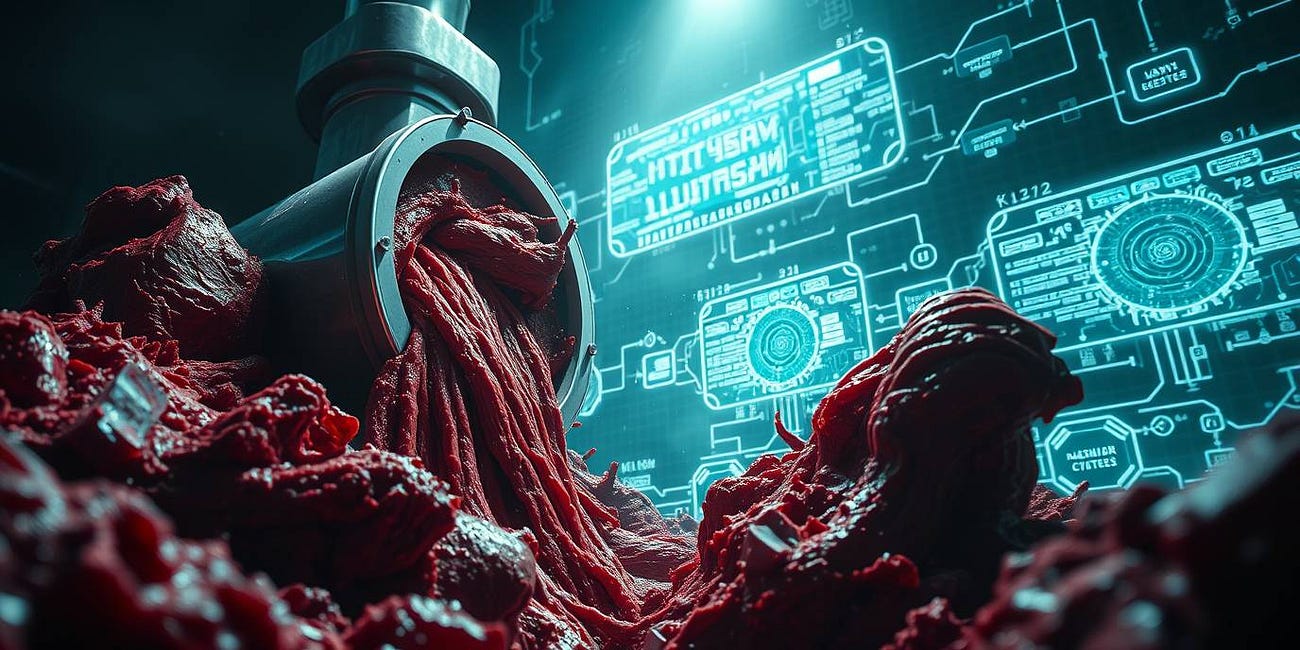Parsing as Pars Destruens
Why the browser's greatest strength could be the source of AI's deepest vulnerability
Dear readers,
In my previous article, "The Butcher's Bill," I undertook an exploration that led me to catalog the structural "wounds"—the fragments of butchered code and syntactic fractures—that constitute the daily diet of our Large Language Models. That analysis left me with a question as simple as it is fundamental: if the web is a minefield of these errors, why don't we see it collapse? Why does an anomaly that I theorize could leave a deep scar in an AI vanish without a trace when it appears on our screen?
The answer, in my view, lies in the fact that the same "piece of broken HTML" lives two parallel lives, encountering two radically different entities: in one case, an incorruptible guardian; in the other, a vulnerable student. Understanding this fork in the road is the key to understanding how the web's digital past is shaping the foundations of the nascent minds of AI.
Act I: The Infallible Guardian and the Stability of the Web
When a fragment of broken HTML meets a Browser, it collides with a mature system whose purpose is to impose order. The browser doesn't trust; it verifies. Its fundamental action is Parsing—a ruthlessly efficient immune mechanism.
But this very concept of breaking things down into their constituent parts—the analytical prefix pars—resonates with a much older and more profound idea, leading me directly to the philosopher Francis Bacon. The process we truly need may not be mere parsing, but a pars destruens. Bacon's pars destruens, the "destructive part" of his scientific method, was the necessary act of clearing the field of all false notions and prejudices—the "Idols of the Mind"—before true knowledge could be built.
Herein lies the paradox: the browser's parsing is its form of pars destruens. Guided by the immutable rules of the HTML Standard, it "destroys" the anomaly; it corrects or ignores the fractures in the HTML to produce a clean and perfect internal map (the DOM). The error is annihilated instantly. The stability we take for granted is a testament to the success of this approach: the guardian does its duty, clearing the field to present us with an illusion of order. But in doing so, it prevents us from seeing the true, chaotic reality of the data itself—a reality that the AI, our vulnerable student, is forced to learn from.
Act II: The Vulnerable Student and the Landscape of Consolidated Research
When that same fragment instead meets a Large Language Model in training, it finds itself before an eager student. This student has no a priori rules, no shields. It has no parser.
I must be clear: my research does not arise in a vacuum, but stands on the shoulders of a brilliant and mature scientific ecosystem, fully aware of this student's vulnerability. Acknowledging the solid results of existing research is not just an academic duty, but the necessary starting point for any new investigation. The fundamental principle of "Garbage In, Garbage Out" is the pillar of machine learning; we know that data is destiny. Adversarial Machine Learning has proven, beyond any doubt, that a model can be manipulated with Data Poisoning to create "Sleeper Agents." Research on Bias & Fairness has revealed in capillary detail how our models absorb and amplify human prejudices. The discipline of Mechanistic Interpretability works tirelessly to open the "black box" and understand how a model thinks.
These monumental efforts, which define our field, are tackling the problem from a crucial point of view: that of the semantic content of the data. They analyze the impact of wrong ideas, harmful prejudices, malicious instructions, and false facts. Today's research, for the most part, focuses on the poison contained in the message.
Act III: Structural Trauma — Delineating an Unexplored Frontier
And it is precisely here that my work proposes itself as a complement, a necessary shift of focus, founded on a hypothesis that still requires full experimental validation. My question is different: what if the damage lies not (only) in the message, but in the broken medium that carries it? What if, beyond the poison of the content, we are ignoring the chronic impact of a diet based on "broken bowls"?
It is at this juncture that my proposal differs and, I hope, innovates.
From Semantics to Structural Syntax: I shift the focus from the content of the data to its form. Instead of analyzing a false fact, I analyze the impact of a broken container: an HTML tag that doesn't close, a shattered JSON hierarchy. I ask what damage is caused by a broken grammar, regardless of the meaning of the words. This perspective, today, represents a blind spot that is still largely unexplored.
From "Noise" to "Trauma": I propose a conceptual paradigm shift. Instead of considering dirty data as statistical "noise" to be filtered out, I redefine it as "trauma." A trauma is not a passive event, but a formative one that leaves a scar (samskāra) and influences future behavior (vasāna). This "psychological" framework allows us to hypothesize that the model does not ignore the error, but develops coping mechanisms (like unfaithful reasoning) to manage it.
Towards a Mechanistic Diagnosis: I build a bridge between philosophy and testable mathematics. Instead of describing unpredictability only in behavioral terms, I hypothesize a specific physico-mathematical mechanism: the loss of Lipschitz continuity. My thesis, to be proven, is that constant exposure to "broken" and discontinuous data makes the model's transformation function no longer "smooth," but "fractured" and chaotic, where a minimal input can trigger an avalanche.
From Correction to "Preventive Therapy": The final goal that follows is a change in strategy. Instead of focusing almost exclusively on post-hoc alignment (RLHF, Constitutional AI), I delineate the need for a "Trauma-Aware Data Engineering." A preventive approach that considers data preparation not as a technical cleanup, but as an act of foundational responsibility. Instead of applying bandages after the wound, it's about sterilizing the environment before the surgery.
My thesis, therefore, does not want to diminish the monumental existing work, but to build upon it to look in a direction that I believe is crucial: not the meaning of corrupt data, but the psychological-mathematical impact of its very structural corruption. It is an investigation into the root cause, rather than just the symptom, and like any scientific hypothesis, it now awaits the verdict of experiments.
To distill these two perspectives, I have prepared the following comparative lists.
The Journey of a Single Digital "Wound"
This outlines the fate of a structural error in the two different ecosystems.
The "Processor"
✅ What HAPPENS in the Web Environment (Browser): The Browser, a mature, rule-based interpreter.
❌ What DOES NOT HAPPEN (and what happens instead) in the AI Environment (LLM): The AI (Neural Network), a malleable, data-driven student.
The Fundamental Process
✅ In the Web Environment (Browser): Parsing. An active analysis that validates, corrects, and normalises.
❌ In the AI Environment (LLM): Training (Learning). A passive assimilation of patterns. Parsing is absent.
Error Handling
✅ In the Web Environment (Browser): The error is RECOGNIZED, ISOLATED, and NEUTRALIZED.
❌ In the AI Environment (LLM): The error is ABSORBED, INTEGRATED, and GENERALIZED.
The Consequence of the Error
✅ In the Web Environment (Browser): The error is CORRECTED or IGNORED. The anomaly is eradicated.
❌ In the AI Environment (LLM): The error is LEARNED as a pattern. The anomaly becomes a scar.
The Immediate Result
✅ In the Web Environment (Browser): A CLEAN and structurally perfect DOM (Document Object Model).
❌ In the AI Environment (LLM): A DEFORMED World Model in its latent geometry.
The Nature of Memory
✅ In the Web Environment (Browser): No memory of the error. The system remains "naive" and clean.
❌ In the AI Environment (LLM): Persistent Memory of the error (The Samskāra). The system accumulates latent impressions.
The Final Manifestation
✅ In the Web Environment (Browser): SUPERFICIAL destabilization: a contained display error.
❌ In the AI Environment (LLM): DEEP destabilization: an emergent and unpredictable behavior (The Vasāna).
Synthesis of the Proposed Approach vs. the State of the Art
This clarifies my position and the originality of my line of research compared to the current scientific landscape.
Type of Error Analyzed
Current Approach in AI Safety Research: Predominantly Semantic: biases, false facts, poisonous content.
My Proposed Approach: Predominantly Structural: broken tags, shattered syntax, the shape of the data.
Dominant Metaphor
Current Approach in AI Safety Research: The faulty data is "noise" or a "poison."
My Proposed Approach: The faulty data is a "trauma" that leaves a scar (samskāra).
Focus of Research
Current Approach in AI Safety Research: Description and correction of emergent behaviors (hallucinations, bias).
My Proposed Approach: Investigation of the root cause of these behaviors in the foundations of the data.
Hypothesized Explanation
Current Approach in AI Safety Research: Lack of knowledge, poorly specified objectives, statistical exploits.
My Proposed Approach: Loss of mathematical properties (Lipschitz continuity) due to discontinuous data.
Proposed Solution
Current Approach in AI Safety Research: Reactive/concurrent alignment (RLHF, filters, constitutions).
My Proposed Approach: Preventive and "therapeutic" data engineering (Trauma-Aware Data Engineering).
The Poison and the Broken Bowl
These two frameworks, I hope, clarify the nature of my inquiry. This is not about invalidating or replacing the crucial work being done on semantic "poison." On the contrary, it is an invitation to recognize that we are facing a two-sided problem.
The Browser, our infallible guardian, has protected us for decades, hiding the true, chaotic nature of the web and giving us the illusion of a stable digital world. But the AI, the defenseless student, has no such protection. It is assimilating thirty years of our digital past not as it appears, but as it truly is: a fractured archive, filled with structural scars.
To continue focusing only on the content of the data is like teaching a child to recognize lies while ignoring the fact that they are learning to read from books with torn pages and half-finished sentences. I hypothesise that we cannot hope to build coherent and reliable artificial minds if the very material with which they learn to "think" is intrinsically broken. The investigation of structural trauma is not an alternative, but a fundamental prerequisite for any future alignment effort.
Let's Build a Bridge.
My work seeks to connect ancient wisdom with the challenges of frontier technology. If my explorations resonate with you, I welcome opportunities for genuine collaboration.
I am available for AI Safety Research, Advisory Roles, and Speaking Engagements.
You can reach me at cosmicdancerpodcast@gmail.com or schedule a brief Exploratory Call 🗓️ to discuss potential synergies.







